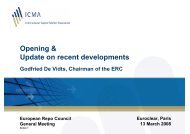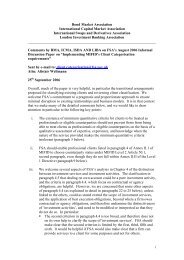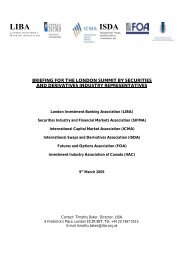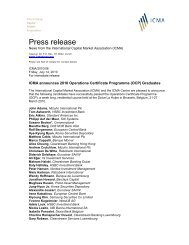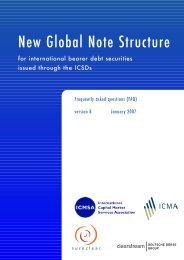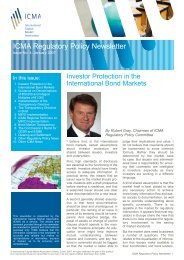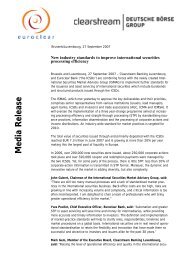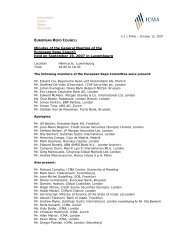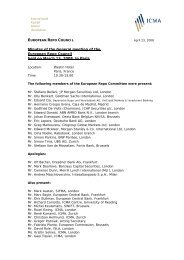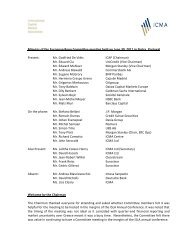Issue no. 22: ICMA Regulatory Policy Newsletter
Issue no. 22: ICMA Regulatory Policy Newsletter
Issue no. 22: ICMA Regulatory Policy Newsletter
Create successful ePaper yourself
Turn your PDF publications into a flip-book with our unique Google optimized e-Paper software.
Euro Commercial Paper<br />
market<br />
Liquidity regulation: The IMF has published How to Address<br />
the Systemic Part of Liquidity Risk, as Chapter 2 of its<br />
April 2011 Global Financial Stability Report. This stresses<br />
why more needs to be done to develop macroprudential<br />
techniques to measure and mitigate systemic liquidity risks<br />
and offers some initial thoughts about how to do it. A priority<br />
should be to design some type of assessment capturing the<br />
negative effect that one institution’s liquidity risk management<br />
decisions could inflict on the rest of the financial system. This<br />
would allow financial institutions to bear more of the burden<br />
they place on central banks and governments. This can be<br />
achieved through a macroprudential tool that could be in<br />
the form of a capital surcharge, a fee, a tax, or an insurance<br />
premium. But such a tool presupposes that policymakers<br />
have a robust methodology for measuring systemic liquidity<br />
risk and each institution’s contribution to this risk.<br />
The chapter proposes three different approaches, all three of<br />
which capture the risks across time and across institutions,<br />
to measure systemic liquidity risk; and macroprudential<br />
tools to mitigate it. The chapter further emphasizes that the<br />
regulatory approach to addressing systemic liquidity risk<br />
should be multipronged and include:<br />
•<br />
•<br />
measures to make funding markets work better by<br />
strengthening the infrastructure underpinning them;<br />
requiring greater oversight and regulation of <strong>no</strong>n-bank<br />
financial institutions that contribute to systemic liquidity risk;<br />
• closer international coordination and greater disclosure of<br />
financial information on relevant funding markets and the<br />
maturity of assets and liabilities; and<br />
•<br />
better evaluation of the overall cost effectiveness of<br />
various macroprudential tools.<br />
SHORT-TERM MARKETS<br />
Money market funds: On 10 May, the SEC hosted a roundtable<br />
discussion on money market funds (MMFs) and systemic<br />
risk, which addressed:<br />
• the potential for money market funds to pose a systemic<br />
risk to broader financial markets – what makes money<br />
market funds vulnerable to runs and how should the role<br />
of money market funds be viewed through the prism of<br />
systemic risk analysis; and<br />
• possible options for further regulatory reform and their<br />
implications, including floating NAV, bank regulation,<br />
and options that reflect a hybrid of these regulatory<br />
approaches: a private liquidity bank; mandatory reserve<br />
or capital requirements; and liquidity fees.<br />
As per its 4 April press release Fitch has updated its global<br />
rating criteria for MMFs. The criteria update, which is part of<br />
Fitch’s periodic review of all rating criteria, provides added<br />
transparency in light of the globally evolving regulatory<br />
landscape for MMFs. The report clarifies and updates certain<br />
elements of Fitch’s MMF rating criteria. However, the core<br />
analytical framework, as outlined by Fitch in October 2009,<br />
remains unchanged. As such, <strong>no</strong> rating actions are expected<br />
as a result of the updated criteria. Key changes to the criteria<br />
include:<br />
• expanded rating criteria to encompass the portfolio<br />
and operating parameters of MMFs rated AAmmf and<br />
Ammf, which may be particularly relevant in light of the<br />
pan-European definition of MMFs;<br />
• updated diversification criteria for direct, indirect and<br />
collateralised exposures in MMFs, including exposures to<br />
the fund’s sponsor or parent;<br />
• an update of those assets recognised for daily and/or<br />
weekly liquidity and explicit recognition of committed<br />
liquidity facilities, when available; and<br />
• clarified treatment of counterparty risk in repurchase<br />
agreements.<br />
<strong>ICMA</strong> <strong>Regulatory</strong> <strong>Policy</strong> <strong>Newsletter</strong> Third Quarter 2011 | 15




